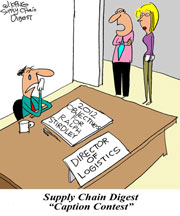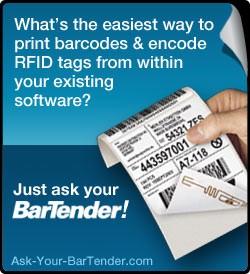 |
January 19, 2012 - Supply Chain Newsletter |
 |
This Week In SCDigest
FEATURED SPONSOR: Seagull Scientific |
To integrate with label software that automatically generates secure and highly-detailed print job logs...
|

NRF 2012 Full Review and CommentI spent two days in Manhattan this week at the National Retail Federation's "Big Show" conference and exhibit. Naturally enough, the show is retail focused, and frankly much more "in store" driven than back end supply chain, but it's well worth it for me to go, and I think the developments at NRF should be of interest to most readers for several reasons. Those include: (1) the consumer goods to retail industry supply chain is frankly our most prominent, and what happens in retail usually directly impacts consumer goods manufacturers too in one way or another; relatedly, many supply chain and technology innovations have their roots in this value chain and have then spread to others sectors; a high percentage of companies in the end are dependent at least in part on what happens in retail (e.g., suppliers to consumer goods manufacturers); and finally, as shoppers it's kind of neat to learn what all is going on there.
So if I have convinced you, please join me for a summary of what I saw and heard. As many of you know, we put out a Video review and comment on my two days at the show earlier in the week, which in part features brief interviews with vendors that displayed what I viewed as interesting new products, and then additionally we split the video in a series of shorter clips so you can pick and choose what you want to see, which you will find here. I have a lot of ground to cover, so will of necessity need to be very concise. From my view, key themes of the exhibit this year were: 1. A huge focus on improved "analytics" - deeper, better insight, moving from descriptive to predictive. As an IBM manager told me, leveraging the increase in the volume, variety and velocity of data today better than the other guy (figuring out how to apply analytics to all the social media stuff, as just an easy example) is increasingly key to success. Vendors pitching new analytic solution were everywhere. 2. Mobility solutions for in-store, with many vendors showing increasingly sophisticated mobile POS systems running on iPads or Android-based tablet computers. Increasingly sophisticated, because the fact that they are mobile means there is additional functionality that might be leveraged versus what can be done with a stationary POS system. 3. A major focus on solutions for better management of multi-channel commerce, specifically distributed order management (DOM) or what might be called DOM plus, to synchronize order capture across multiple channels and points of interaction (POIs) with inventory and precise order fulfillment. The really interesting thing here is that almost uniquely, there seems to be general agreement that the problem is purely technology, or lack thereof. Not process or execution - if you lack the right technology, there are just certain things that just can't be done. In a breakout session, Brooks Brothers' CFO, for example, said the retailer is trying to get to "order on-line, pick up at store," and the reason they can't yet is a pure technology one. 4. Not surprisingly, a lot of emphasis on "cloud-based" solutions, notably for POS but also for other applications such as Distributed Order Management. Most promoted the idea as being for mid-market retailers, but I suspect in the end many larger merchants will be interested too, especially with the dynamic nature of the industry (stores opening and closing). My one comment: knowing what I do, for example, about all the system redundancy a grocer like Kroger has developed to almost eliminate the possibility of the POS system going down at a store, can cloud-based providers really guarantee that level of uptime? I was frankly a little disappointed in the very modest level of direct supply chain related sessions in the conference track, and my sense was retail supply chain solutions were not very prominent on the show floor either. Major supply chain vendors such as RedPrairie, Manhattan Associates and JDA Software were certainly pitching their supply chain solutions, but featured much more prominently core retail applications. That's no surprise of course for JDA, but many readers may not realize how much effort RedPrairie and Manhattan are putting into more direct retail applications, although they are getting there by very different means. Given the relative hype and apparent real promise of item-level RFID in the apparel and soft goods industry, I was a little surprised it was so hard to find much in the way of RFID solutions on the show floor (there were a few), and RFID was basically absent as a topic from the breakouts other than one major session on Sunday. In that session, highlights of a pilot program in the apparel industry I hadn't heard of were presented, in which RFID was used at some 27 touch points, from fabric production in China all the way to store shelf. Results were said to be very positive. We hope to report on the study in more detail shortly. I was interested to hear Macy's, global trade giant Li & Fung, and standards group GS1 are working together on standards and processes for such end to end tracking. Macy's gave some updates on its previously announced RFID program, saying it intends to track all replenishment items via RFID by the end of 2012. Another session focused on e-commerce shipping policies, and the news was the clear trend is for free shipping on everything, or nearly so. I hadn't heard that LL Bean went to totally free for initial shipments and returns regardless of sales total in March of 2011. Overstock.com's CEO Patrick Byrnes noted that even though the web merchant charges only $2.95 for shipping, it sees a clear sales lift when it drops shipping to just $1.00. That surprises me. Byrnes also warned that when such shipping promotions are ended, sales for awhile actually drop down below the baseline, and that free shipping inevitably drops the size of the consumer's cart compared with having a minimum required for free shipping. The bottom line for me: shippers have to get serious about optimizing parcel shipping costs, through technology and tactics like zone skipping and others where appropriate. The impact on the bottom line for e-commerce units can be huge. I am out of room to highlight more than a handful of the new solutions I really liked. All those below plus a few others are featured on the videos. They include: A functionally rich, very nice looking mobile POS application from a company called Stella Nova, running on a Motorola Android tablet. Inside the Motorola both, the Stella Nova section was literally packed the entire show. I saw a large number of both large and small retailers anxious to take a look. Of the analytics apps, I was intrigued by the "video analytics" solution from a vendor called ClickIt. They use in-store cameras to turn "video into data," looking at things like line queues, how long shoppers stop at end of aisle displays, and much more. The basic technology has potential use in distribution center analysis as well, and ClickIt tells me they have had requests for analysis of DC pick lines. The new Logistics Flow Control application from Descartes Systems is very cool, and in an overly brief summary, provides visibility to retailers about what is coming at them from suppliers, as well as enabling them to more automatically combine multiple shipments and see potential compliance violations before they occur, among other tools. In a really cool part, the application brings in carriers, especially LTL carriers (which cause a lot of variability into the flow of goods), giving retailers more precise control of inbound logistics flows. Manthan Systems' new supplier portal offering was very impressive, with very broad functionality. Wincor Nixdorf showed a new concept for the bar code scan tunnel for rapid grocery checkout pioneered by Kroger at last year's show - and the design is very cool. I also very much liked JDA's new Customer Engagement solution, as well as RedPrairie's new Cloud Commerce offering, which both have elements of the DOM plus solutions mentioned above, though they come at it from different angles. See the videos. Finally, hats off to Motorola, and its "innovation bar," where the company had about every device it makes - and that's a bunch of them - were there for booth visitors to see, play around with, compare, and ask questions of experts. It was packed - and a really neat idea. Why don't more exhibitors, including software providers, think more like this? What's your reaction to Gilmore's NRF 2012 review? Any cool new products that you saw that Gilmore missed? Do we need a little more supply chain back at NRF? Let us know your thoughts at the Feedback button below.
|
|
||||||||||||||||||||||||||
Feedback will return next week. |
||
SUPPLY CHAIN TRIVIA ANSWER
Q: Toyota lost its crown in 2011 as the top global auto seller in 2011, due to production issues stemming from the Japanese earthquake. Which auto OEM replaced Toyota at the top?
A: While initial reports said GM regained the top spot, some say that included some sales from one division to another that shouldn’t have been counted. That would put Germany’s Volkswagen in the top spot.
| © SupplyChainDigest™ 2003-2011. All Rights Reserved. SupplyChainDigest PO Box 714 Springboro, Ohio 45066 |
POWERED BY: XDIMENSION |





